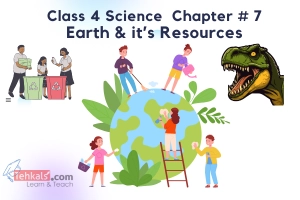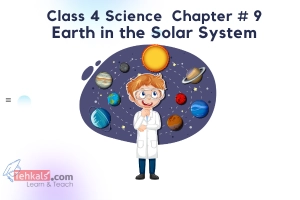Class 4 Science MCQs Chapter 8
Published: 2 Oct 2022
Welcome to tehkals.com, your go-to destination for Class 4 Science MCQs Chapter 8. Explore our comprehensive collection of Class 4 Science MCQs of Chapter No. 8, focusing on “Earth’s Weather and its Resources.”
If you want to succeed and clear your PST, CT, DM, PT, CT, TT, SST, and SS Tests, then our comprehensive MCQs (Multiple Choice Questions) provide the perfect solution by giving the treasure of knowledge and bank of MCQs.
Class 4 Science MCQs Chapter 8
Earth’s Weather and its Resources
Chapter No. 8 Test # 1
1. The daily condition of the environment or atmosphere of a location is called its_________.(a) Weather
(b) Climate
(c) Space
(d) Rain
Show Answer
Weather
2. Weather is described in terms of:
(a) Temperature, humidity in air
(b) Clouds and winds
(c) Precipitation (rain or snow)
(d) All of these
Show Answer
All of these
3. Annual rotation of the Earth around the sun and the tilt of the Earth on its axis are responsible for the changes in the ________.
(a) Weather
(b) Climate
(c) Space
(d) Rain
Show Answer
Weather
4. The general conditions of an area are called _______.
(a) Weather
(b) Climate
(c) Space
(d) Rain
Show Answer
Climate
5. The average weather conditions of an area are called _______.
(a) Weather
(b) Climate
(c) Space
(d) Rain
Show Answer
Climate
6. _______ describes the general and long-lasting weather conditions of an area.
(a) Weather
(b) Climate
(c) Space
(d) Rain
Show Answer
Climate
7. The study of weather conditions is called ________
(a) Weatherology
(b) Cacology
(c) Meteorology
(d) None of these
Show Answer
Meteorology
8. The people related to the study of weather conditions are called_______.
(a) Scientist
(b) Astronaut
(c) Meteorologists
(d) None of these
Show Answer
Meteorologists
9. Short duration conditions of an environment are called __________.
(a) Weather
(b) Climate
(c) Space
(d) Rain
Show Answer
Weather
10. Average long duration conditions of weather are called ________.
(a) Weather
(b) Climate
(c) Space
(d) Rain
Show Answer
Climate
11. This year, it is expected that Monsson rains will begin early is an example of ________
(a) Weather
(b) Climate
(c) Space
(d) Rain
Show Answer
Climate
12. _________ is the instrument used to measure the air pressure.
(a) Anemometer
(b) Barometer
(c) Rain gauge
(d) Thermometer
Show Answer
Barometer
13. _____ is the instrument used to measure the speed and direction of wind.
(a) Anemometer
(b) Barometer
(c) Rain gauge
(d) Thermometer
Show Answer
Anemometer
14. _____ is the instrument used for the measurement of the amount of the rain.
(a) Anemometer
(b) Barometer
(c) Rain gauge
(d) Thermometer
Show Answer
Rain gauge
15. _____ is the instrument used for the measurement of temperature of air.
(a) Anemometer
(b) Barometer
(c) Rain gauge
(d) Thermometer
Show Answer
Thermometer
16. The movement of _______ in the upper atmosphere of a region helps us to predict the change in weather conditions for the next few days.
(a) Winds
(b) Clouds
(c) Both a & b
(d) None of these
Show Answer
Both a & b
17. Who provides us information about rain, wind or storm etc. in advance?
(a) Scientist
(b) Astronaut
(c) Meteorologists
(d) None of these
Show Answer
Meteorologists
18. The maximum rain in one day in Pakistan was recorded on 23rd July 2001 in Islamabad is________.
(a) 620mm
(b) 720mm
(c) 630mm
(d) 730mm
Show Answer
620mm
19. The maximum day temperature of _________centigrade was recorded in 1922 in the desert of Libya (Africa).
(a) 48 degrees
(b) 50 degrees
(c) 58 degrees
(d) 38 degrees
Show Answer
58 degrees
20. The maximum temperature in Pakistan was ¬¬¬¬___________ in Turbat (Balochistan) on 28th May 2017.
(a) 48 degrees
(b) 53.7 degrees
(c) 58 degrees
(d) 38 degrees
Show Answer
53.7 degrees
21. On 26th May, 2010, in Mohenjo Daro (Sindh) the maximum temperature was found ________oC
(a) 53.7
(b) 53.5
(c) 50
(d) 40
Show Answer
53.5
Chapter No. 8 Test # 2
22. The climate or weather changes of any region depend upon falling of ________ rays vertically or slanting.(a) Sun
(b) Moon
(c) Wind
(d) None of these
Show Answer
Sun
23. The equator is an ________line that divides the Earth into two equal parts.
(a) Real
(b) Big
(c) Imaginary
(d) None of these
Show Answer
Imaginary
24. On the basis of the climate, we can divide the Earth into _______zones.
(a) Two
(b) Three
(c) Four
(d) Five
Show Answer
Three
25. ________zone of the regions located around the equator.
(a) Tropical
(b) Temperate
(c) Polar
(d) None of these
Show Answer
Tropical
26. In tropical zone, the sun rays fall ________
(a) Vertically
(b) Horizontally
(c) Slant
(d) None of these
Show Answer
Vertically
27. The climate of tropical zone is_________.
(a) Cold
(b) Coldest
(c) Hot
(d) Mild
Show Answer
Hot
28. ________zone is located between tropical and polar zone.
(a) Tropical
(b) Temperate
(c) Polar
(d) None of these
Show Answer
Temperate
29. In temperate zone, the sun rays fall ________
(a) Vertically
(b) Horizontally
(c) Slant
(d) None of these
Show Answer
Slant
30. The climate of temperate zone is ________.
(a) Cold
(b) Coldest
(c) Hot
(d) Mild
Show Answer
Mild
31. Polar zone consists of the areas around the ________ poles of the Earth.
(a) North
(b) South
(c) Both a & b
(d) None of these
Show Answer
Both a & b
32. In polar zone, the sun rays are ________
(a) Vertically
(b) Horizontally
(c) More Slant & weak
(d) None of these
Show Answer
More Slant & weak
33. The climate of the polar zone is ___________.
(a) Cold
(b) Coldest
(c) Hot
(d) Mild
Show Answer
Coldest
34. Water bodies make the climate of the adjacent land areas _________.
(a) Cold
(b) Coldest
(c) Hot
(d) Mild
Show Answer
Mild
35. With the rise of height from the sea level, the climate becomes_________.
(a) Hot
(b) Hottest
(c) Cooler
(d) None of these
Show Answer
Cooler
36. The minimum temperature in Pakistan was _______ degree Centigrade in Quetta on 8th January 1970.
(a) 18
(b) -18
(c) 0
(d) 35
Show Answer
-18
37. The ____ in the average temperature of the Earth is called global warming.
(a) Increase
(b) Decrease
(c) Cold
(d) Coldest
Show Answer
Increase
38. If it rains suddenly, what do you observe?
(a) Weather condition
(b) Climate
(c) Weather and climate
(d) Location
Show Answer
Weather condition
39. Which zone of the Earth receives vertical sun rays?
(a) Temperate
(b) Tropical
(c) Polar
(d) All of these
Show Answer
Tropical
40. The climate of the region of polar zone is:
(a) extremely cold
(b) Warm
(c) Humid
(d) Mild
Show Answer
extremely cold
41. Due to smoke and gases emitted from factories and vehicles, the average temperature of the Earth is:
(a) Increasing
(b) Decreasing
(c) Not affected
(d) Sometime increasing and sometime decreasing
Show Answer
Increasing
42. In how many zones the Earth is divided on the basis of climate?
(a) 2
(b) 3
(c) 4
(d) 5
Show Answer
3






Your attention to detail and creativity really shine through in Excellent work.